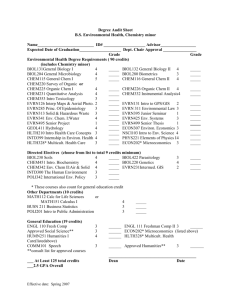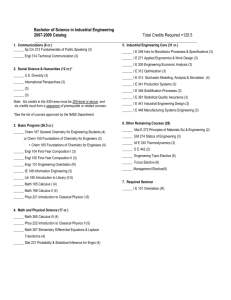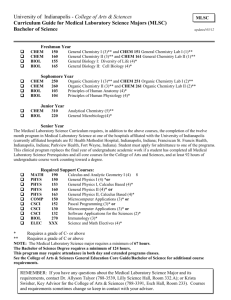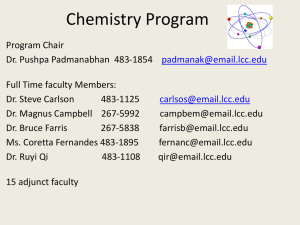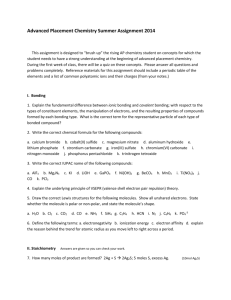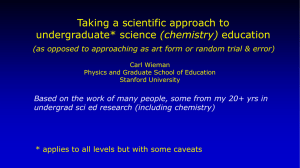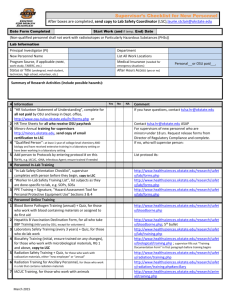Labs - Images
advertisement
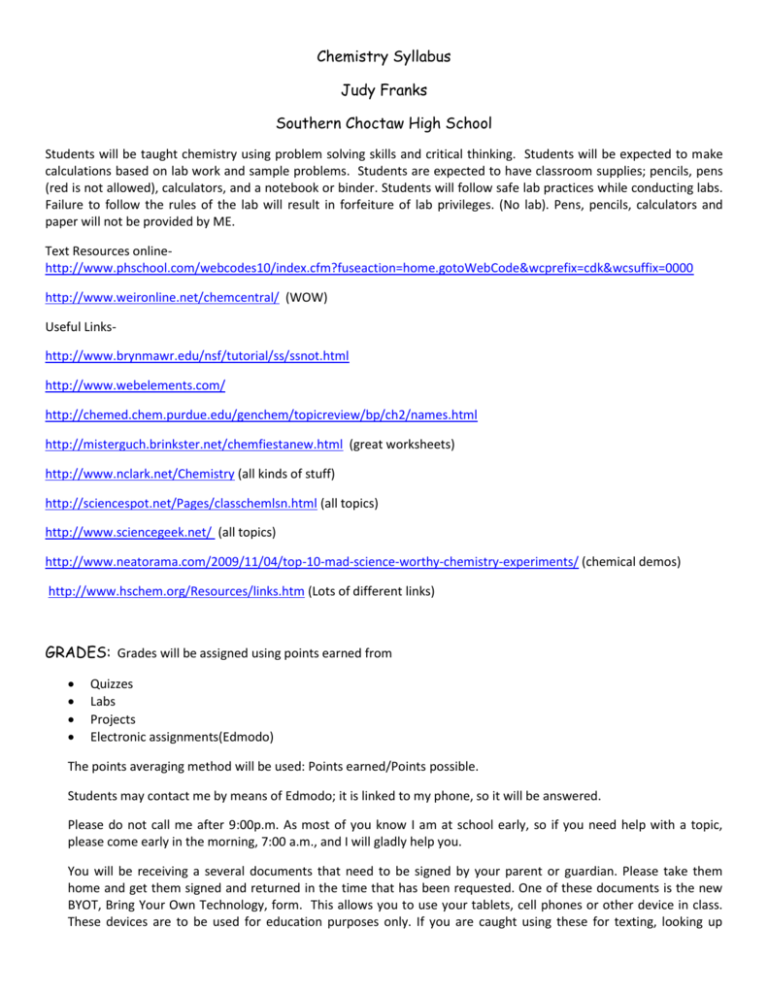
Chemistry Syllabus Judy Franks Southern Choctaw High School Students will be taught chemistry using problem solving skills and critical thinking. Students will be expected to make calculations based on lab work and sample problems. Students are expected to have classroom supplies; pencils, pens (red is not allowed), calculators, and a notebook or binder. Students will follow safe lab practices while conducting labs. Failure to follow the rules of the lab will result in forfeiture of lab privileges. (No lab). Pens, pencils, calculators and paper will not be provided by ME. Text Resources onlinehttp://www.phschool.com/webcodes10/index.cfm?fuseaction=home.gotoWebCode&wcprefix=cdk&wcsuffix=0000 http://www.weironline.net/chemcentral/ (WOW) Useful Linkshttp://www.brynmawr.edu/nsf/tutorial/ss/ssnot.html http://www.webelements.com/ http://chemed.chem.purdue.edu/genchem/topicreview/bp/ch2/names.html http://misterguch.brinkster.net/chemfiestanew.html (great worksheets) http://www.nclark.net/Chemistry (all kinds of stuff) http://sciencespot.net/Pages/classchemlsn.html (all topics) http://www.sciencegeek.net/ (all topics) http://www.neatorama.com/2009/11/04/top-10-mad-science-worthy-chemistry-experiments/ (chemical demos) http://www.hschem.org/Resources/links.htm (Lots of different links) GRADES: Grades will be assigned using points earned from Quizzes Labs Projects Electronic assignments(Edmodo) The points averaging method will be used: Points earned/Points possible. Students may contact me by means of Edmodo; it is linked to my phone, so it will be answered. Please do not call me after 9:00p.m. As most of you know I am at school early, so if you need help with a topic, please come early in the morning, 7:00 a.m., and I will gladly help you. You will be receiving a several documents that need to be signed by your parent or guardian. Please take them home and get them signed and returned in the time that has been requested. One of these documents is the new BYOT, Bring Your Own Technology, form. This allows you to use your tablets, cell phones or other device in class. These devices are to be used for education purposes only. If you are caught using these for texting, looking up answers or other unacceptable practices you will lose your privileges in this class to have these devices for the remainder of the year, no exceptions. Topics to be Covered Times may change due to unexpected interruptions in the school schedule. Week One-Introduction to Chemistry (1) Students will go to www.edmodo.com and join their assigned class. Chapter One- Introduction to chemistry (read chapter) Lab Safety and Quiz Inquiry Activity, page 6 Interpret Graphs Choose a plant or animal from which we obtain medicine and research the medicine. Write a five paragraph essay about your research. Please be sure not to use text language. Review problem solving strategies.(analyze, calculate, and evaluate) Chapter Test For extra credit you will be assigned a concept challenge problem.(page 36. Week Two and Three- Matter and Change (2) Inquiry Activity (page 38) Read the chapter and be familiar with vocabulary. Know the difference between extensive and intensive properties and be able to give examples. Know the difference between physical and chemical changes and be able to give examples. Know the difference between physical and chemical changes and be able to give examples. Labs- Mel temp Machines and Extraction of Dyes (1) Know the ways mixtures can be separated Distinguish between elements and compounds and solutions and mixtures. Chapter Test Extra Credit- Challenge Problem page 61. Week Four and Five- Scientific Measurement (3) (Lots of Math) Calculators!! Scientific Notation, Scientific Digits, Accuracy and Precision and Error and Rounding Quiz Learn the metric prefixes and equalities Convert metric units using dimensional analysis Lab- Measurement Challenge and Significant Digits (2) http://intro.chem.okstate.edu/1215SP2000/ProblemSet/sigfigures.html http://www.brynmawr.edu/nsf/tutorial/ss/ssnot.html Accuracy and Precision Lab (3) Temperature Scales and Conversions Quizzes on prefixes and conversions Density –D=m/v, be able to manipulate the equation and solve for each variable Denisty of a liquid and Microdensity of Plastic Lab (4-5) Chapter Test Week Six and Seven- Atomic Structure (4) (Read the chapter and become familiar with the vocabulary) Know the early contributors to our knowledge of the atom-Democritus and Dalton(Atomic theory) Know the subatomic particles that make up the atom. Know who discovered them, their location, their charge, and their size Activity on Subatomic Particles http://intro.chem.okstate.edu/1215SP2000/ProblemSet/protons.html Rutherford’s Gold-Foil Experiment Know the significance of the atomic number, atomic mass, and mass number Compare and contrast atoms, ions, and isotopes Lab on isotopes Chapter Test Week Seven and Eight-Electrons in Atoms (5) (Read chapter and become familiar with the vocabulary) Inquiry Activity(page 126) Different models of the atom-timeline Quantum Mechanical Model Extraction of Dyes (6) Atomic Orbitals and Electron configurations Aufbau Principle, Pauli Exclusion Principle, and Hund Rule Quiz on electron configurations Electromagnetic Spectrum Research the uses of light. Five paragraph essay Chapter Test Extra Credit from page 151, critical thinking Week Nine- Catch Up and Nine Weeks Test Week Ten-Periodic Table (6), Read Chapter and become familiar with the vocabulary. Students will learn the symbols for elements in columns 1-2,13-18 http://www.rsc.org/periodic-table http://science.widener.edu/~svanbram/ptable.html http://www.webelements.com/ Quizzes Students will learn the location of the metals, metalloids, non metals, transition elements Know the history of the periodic table and the men who contributed to its origin Lab- 39 Drop Lab (7) Periodic Law Activity- Create a periodic table, learn what information is provided in the squares of the periodic table Re visit electron configurations Periodic Trends Chapter Test Week Eleven- Ionic, Metallic and Covalent Bonding (7-8) Compare and contrast ionic and molecular compounds. Week Twelve/Thirteen-Chemical Names and Formulas (9) Be able to name compounds and write formulas for: ionic compounds, molecular compounds, and acids and bases http://chemed.chem.purdue.edu/genchem/topicreview/bp/ch2/names.html http://intro.chem.okstate.edu/1215SP2000/ProblemSet/namestoformulas.ht ml http://intro.chem.okstate.edu/1215SP2000/ProblemSet/naming.html http://intro.chem.okstate.edu/1215SP2000/ProblemSet/namestoformulas.ht ml Know the rules for each type of compound. Lab- Metals, Nonmetals, and Metalloids (8) Week Fourteen /Fifteen- Chemical Quantities (10) Students will learn the vocabulary and read the content Students will be able to calculate the mass of elements and compounds http://intro.chem.okstate.edu/1215SP2000/ProblemSet/massmoles.html Students will calculate percent composition Lab- Color of Chemistry/ Chemical Reactions (9-10) Students will be able to determine the empirical and molecular formula Week Sixteen/ Seventeen- Chemical Reactions (11) Students will be able to determine the type of reaction http://intro.chem.okstate.edu/1215SP2000/ProblemSet/startbalancerxns.h tml Lab- Identification of Solutions (11) Students will be able to predict the products in a reaction Students will be able to balance equations Week Eighteen- Midterm Test SECOND SEMESTER Week Nineteen (1) - Review writing formulas, balancing equations Week Twenty/Twenty-one (2)-Stoichiometry (12) Read the chapter and know the vocabulary Students will be able to balance equations and then convert the given units into the units wanted Grams to moles; moles to grams; moles to moles; moles to particles; Particles to moles; moles to volume; volume to moles and any other variation http://intro.chem.okstate.edu/1215SP2000/ProblemSet/startlimitwp.html Week Twenty-two/ Twenty-three-States of Matter (13) vocabulary and content Students will review the types of matter Gas Laws (14) Read and be able to manipulate the gas law equations Be able to match the gas law with the scientist Be able to manipulate the gas law equation Be able to convert the temperatures Be able to interpret the question and pick the correct formula to calculate the answer http://www.chemtutor.com/gases.htm Week Twenty-four- Water Solutions and Solutions (15-16) Read and know the terms Compare and contrast polar and nonpolar solutions Discuss the different types of solutions, colloids, suspensions, Week Twenty-five-(17) Thermo chemistry Introduction to topic- vocabulary Calculate the amount of heat lost or gained Week Twenty-six-(18) Reaction Rates Introduction to topic Week Twenty-seven/ Twenty-eight (19) Acids and Bases Define acids and bases Calculate the pH of a solution and its concentration Discuss the uses of acids and bases Neutralization reactions

